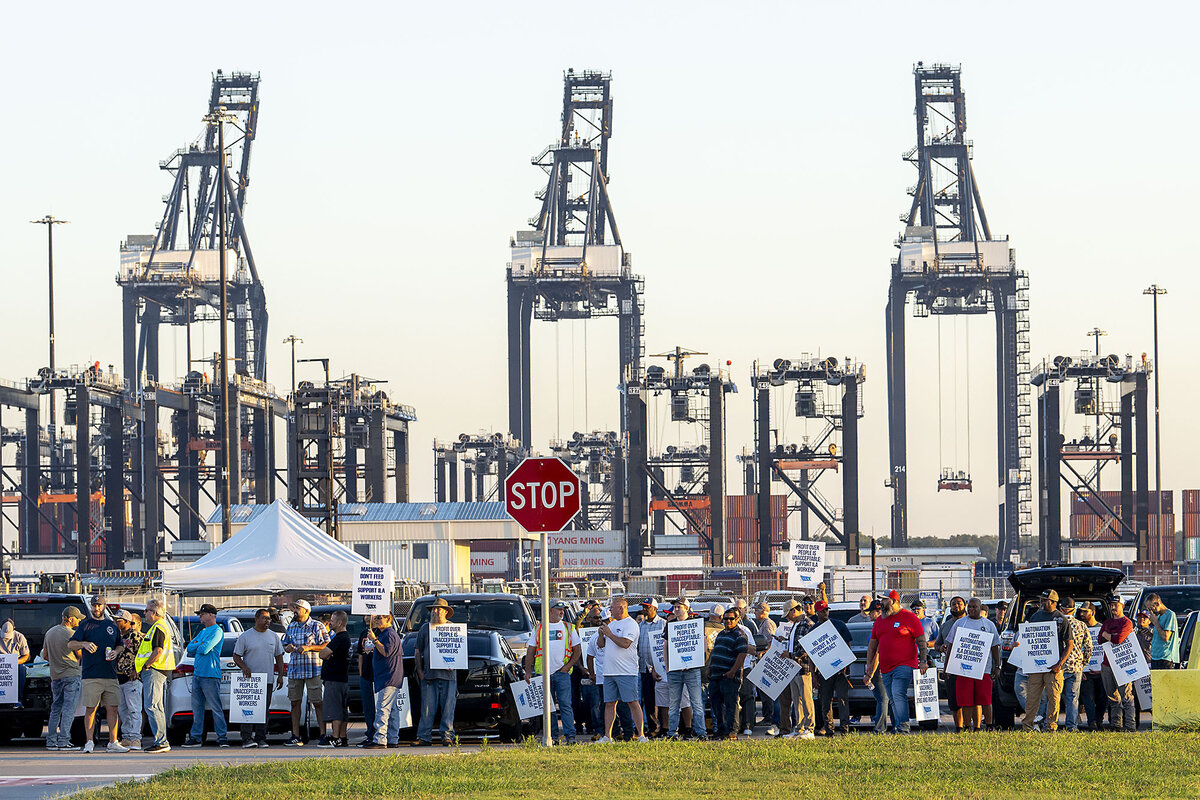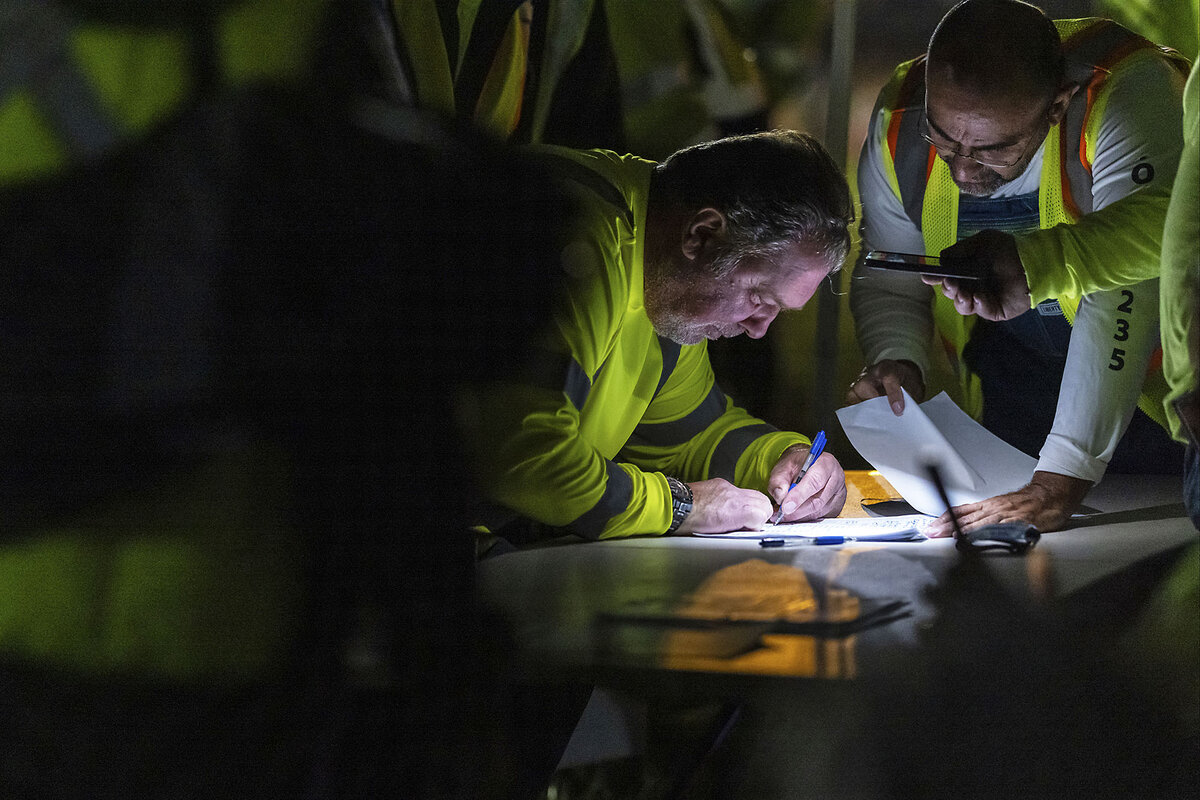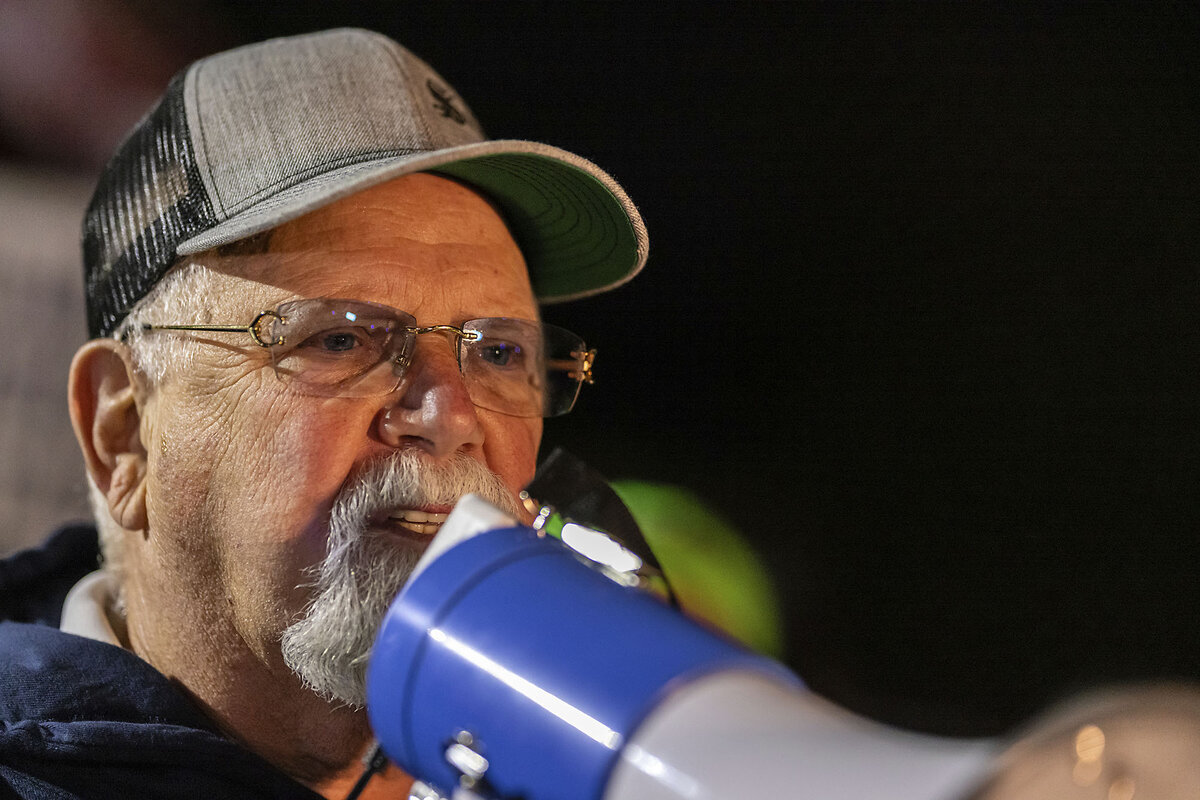Dock strike threatens economy before election and holidays
Loading...
At a minute past midnight Tuesday morning, the clock started ticking on one of America’s most potentially consequential and disruptive strikes in recent memory. Dockworkers walked off the job at America’s east coast and Gulf Coast ports from Boston to Houston, their first work stoppage in almost 50 years.
Economically, the strike puts a hard stop on nearly half of America’s imports and a good share of exports. Politically, it puts Democratic presidential nominee Kamala Harris in a bind with Election Day exactly five weeks away. Does she push the administration to step in and temporarily end the strike, angering her union base? Or does she work behind the scenes, hoping the two sides settle before consumers feel the pinch?
Such overarching strikes rarely last very long, labor historians say, because so much money is at stake that both sides are eager to settle.
Why We Wrote This
Workers unions have enjoyed a boost in popularity since the ’70s with the absence of major strikes. The new dockworker strike, which began on Tuesday, may challenge that popularity and test the Biden-Harris administration.
But “If we’re talking about a monthlong strike where you do start to see actual things disappear from the shelves – like there’s shortages on Christmas goods – then I can see that as being a negative” for the vice president, says Erik Loomis, a labor historian at the University of Rhode Island in Kingston.
At the moment, neither pro-labor Vice President Harris nor President Joe Biden is signaling that they would use their executive powers, which allow them to impose an official 80-day cooling-off period in which strikers return to work to prevent stoppages that threaten the health or safety of the United States.
Everything from clothing to cherry imports could be affected
The ports on strike, which employ some 45,000 members of the International Longshoremen’s Association, handle half or more of clothing, footwear, and agricultural imports coming in by ship, as well as a large portion of America’s imported cars, car parts, ingredients for making pharmaceuticals, machinery, fabricated steel and precision instruments. They also handle a substantial percentage of exports, especially agricultural goods.
While most of these goods can be stored for months, that’s not the case for perishables like imported cherries (90% flow through these ports) or bananas (25%).
These goods come by container – the brightly colored rectangular steel boxes piled up on ships – and dockworkers play an essential role in loading and unloading those containers. (Cargo that doesn’t arrive in containers – such as oil, gas, and coal – is not affected by the strike.)
The impact of the work stoppage won’t be felt immediately. Retailers, grocers, and even state governments have been preparing for a walkout for months, rerouting shipments to west coast ports that aren’t on strike or ordering early to ensure they’d have enough candy on hand for Halloween and apparel and shoes for Christmas.
“New York has been working around the clock to ensure that our grocery stores and medical facilities have the essential products they need,” New York Gov. Kathy Hochul said in a statement early Tuesday morning.
Unions grow bolder
The strike represents a new assertiveness among unions, say labor economists and historians, from the rise of independent unions at places like Starbucks and Amazon to the big contract win by a newly aggressive United Auto Workers last year. The dockworkers’ dispute centers around pay and automation, with union members eager to make up for buying power lost to inflation during their most recent six-year contract.
But pay may not be the biggest issue. On Monday, the union reportedly turned down a last-minute offer for a nearly 50% increase in pay, according to the United States Maritime Alliance, which represents the port terminal operators and carriers.
Automation may be a bigger grievance. In June, the union accused members of using an automated system for processing the entrance and exits of trucks at ports, which it claimed violated the current contract. Talks stalled after that.
With a base salary of $81,000 a year (and some members earning over $200,000 with lots of overtime), the union reportedly is now demanding a 77% raise over its six-year contract and no further automation of operations. Two key dockworker jobs – operating cranes and moving containers – can now be done by remote-controlled machines.
Strikes can help make unions stronger
Major strikes can build support for unions. Widespread teacher strikes in 2018 managed, on the whole, to win parents’ support because the teachers lived in their communities, parents could identify with their struggles over low pay, and the community came to believe that the teachers’ demands would benefit its children, according to research by Alexander Hertel-Fernandez, a political scientist at Columbia University in New York.
But strikes can also backfire if workers can’t connect with the public. With their high pay, work largely invisible to the general population, and a union with a past history of ties to organized crime, the dockworkers face an uphill battle.
The flip side of that story is that the International Longshoremen’s Association has, over the years, made an implicit pact with employers, accepting advances in technology that reduce jobs in exchange for higher pay for those who keep working.
“The reason they’re making $200,000 a year is because they’re one of the few unions that were able to capture, for their remaining members, the fruits of the technological innovation,” says Nelson Lichtenstein, a historian at the University of California, Santa Barbara. That may prove a positive narrative for Americans at a time when newer innovations, like artificial intelligence, threaten to change or eliminate their jobs, he adds.
The political impact of the strike will depend not only on how long it lasts, but also on how the presidential candidates respond.
A month after the 2022 election, President Biden signed legislation blocking a potential railroad strike that would have posed similar logistical problems for the U.S. In a statement Tuesday, the White House said that Mr. Biden and Ms. Harris were closely monitoring the dockworker strike’s impact on supply chains.
Former President Donald Trump may also have to tread carefully, says Mr. Lichtenstein. “These longshoremen are, from the Republican point of view, the kind of workers they want to appeal to” – especially in coastal swing states with ports, such as Georgia and North Carolina.









